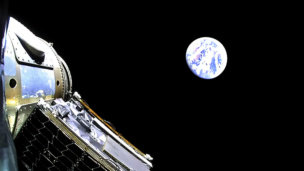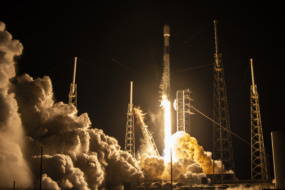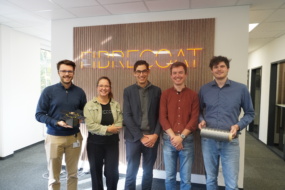While government-operated orbital outposts may not have the amenities of future private stations, in-space internet, it would appear, will be table stakes.
Driving the news: NASA’s Lunar Gateway module, set to begin launching in a few years, will serve as a comms hub, a research lab, short-term living quarters for astronauts, and a holding bay for rovers and other Moon-bound machines.
- Northrop Grumman is the prime contractor for Gateway’s HALO module.
- HALO = the Habitation and Logistics Outpost. It will be the first crewed module for Artemis-era astronauts from the US, Europe, Japan, and Canada.
Earlier this week, Northrop announced that it had subcontracted Solstar Space, a five-year-old startup, to provide two-way internet services for HALO and the lunar orbiting space station. Solstar’s bread and butter = developing “Wi-Fi Access Points” that could eventually be put to use on satellites, orbital outposts, and space vehicles.
We had a chance to catch up with Brian Barnett, Solstar’s founder and CEO, to hear a bit more about in-space internet, tweeting from LEO, and the complexities of extending wireless internet access points to a lunar orbit.
To the uninitiated, how would you describe your product?
We are developing the first Wi-Fi Access Point designed for use in human-rated capsules in Earth and lunar orbit. We are also developing a line of “space communicators” that would allow persistent communication with space-based assets from any internet-connected device.
What have you learned about your technology on your suborbital hops?
We first tested a Wi-Fi hotspot inside Blue Origin’s New Shepard rocket back in 2018. We used commercial telecom constellations to provide an internet connection to the spacecraft, then used the Solstar hotspot inside the capsule to post the first commercial tweet from space.
These proof-of-concept flights were largely paid for by NASA’s Flight Opportunity program, which was a huge help. From these flights we learned that we could maintain a connection between commercial satellites and our space communicator installed on the spacecraft during all phases of the flight: on the launchpad, on the ascent to space, in space above the Karman line, and all the way back to Earth. Media outlets dubbed Solstar the “first internet service provider (ISP) in space” after those successful flights.
How much more complex or expensive is it to successfully prove this orbitally? And then, I assume, it gets an order of magnitude more complex for a lunar orbit?
Flying our space communicators in LEO is definitely more complex than suborbit. There are a lot of similarities too, but in LEO we are flying 200 miles higher than suborbit at velocities about 7 times faster.
We’ve been doing R&D on these issues for a decade so we are up to the challenge.
Our Wi-Fi Access Points will function quite similarly in LEO as in cislunar orbit when mounted inside space stations or other spacecraft. Of course, the moon is 238,000 miles from Earth, so we have to design certain features to enable troubleshooting from Earth when necessary.
Beyond the demands of the day job, do you have any ideas for how astronauts in the HALO module may use your Wi-Fi? Netflix? Twitter? FaceTime?
Our goal is to allow the astronauts to treat our Wi-Fi Access Point just like they would the ones in their homes. The main use of our Wi-Fi will be for official NASA business to provide critical communications between the astronauts and mission control at JSC and payload support from Huntsville.
Having said that, we expect there will be a fair amount of social media use, as well as the occasional FaceTime with family members, as we know how important this is for the astronauts’ state of mind. Overall, we’re extremely excited to be providing the communications necessary to enable mission success.
Do you worry about in-space Wi-Fi competition from SpaceX/Starlink?
As a new space innovator, we are very agile. We see companies like SpaceX and many others as opportunities for partnership. Our space communicators and Wi-Fi Access Points are designed for use with commercial constellations. Our mission is to continue to advance the way we communicate with objects and humans in space and welcome collaborative efforts with many companies across the industry.
Do you intend to bring Wi-Fi to the surface of the Moon?
Yes we do! We’re developing a product specifically designed to be radiation hardened. With this added capability, our Wi-Fi Access Points could conceivably be used on the Moon, on Mars, and beyond.




